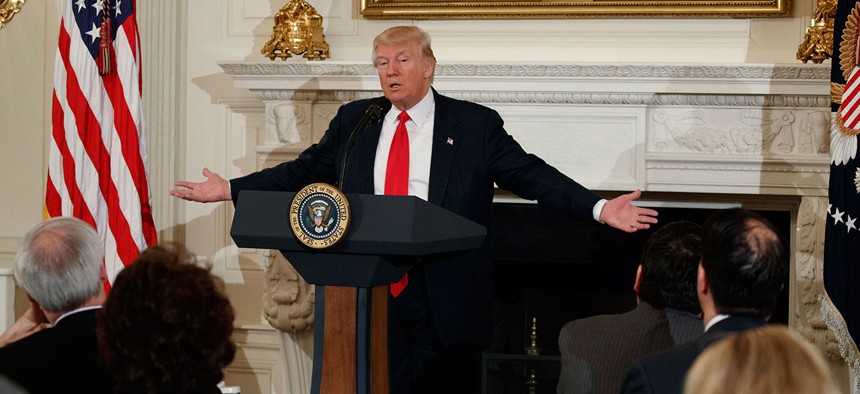Trump’s Budget Will Require 10 Percent Spending Cuts at Non-Defense Agencies
Agencies must identify $54 billion in savings in “lower priority programs.”
This story has been updated with additional details from OMB and the White House.
The Trump administration will require $54 billion in cuts at non-national security federal agencies in its preliminary fiscal 2018 budget proposal, an Office of Management and Budget official said Monday. Nearly every domestic agency will shoulder a share of the reductions.
The spending decreases will offset an equal increase in spending at the Defense Department, which the official said will primarily be given to the Pentagon to spend as it sees fit. The proposed boost, which still must go through the congressional appropriations process, would represent about a 10 percent increase to the Defense budget. The White House will propose that foreign aid be cut to partially offset the new spending.
The OMB official called the forthcoming blueprint, which the White House will release in March, a “security budget” that will put America first. It will focus only on top-line allocations to major agencies, with a full budget coming later in the year. It will give direction exclusively on discretionary spending, with any proposals on mandatory spending also coming later. Overall, the cuts represent about a 10 percent decrease to non-Defense discretionary spending. Trump's budget will propose $462 billion in total non-Defense discretionary spending in fiscal 2018, down from the the budget cap agreed to in 2015 of $516 billion. Defense spending would jump from the agreed to cap of $549 billion for fiscal 2018 to $603 billion.
Trump, in theory, would need authority from Congress to break the Defense caps set in budget deals at the expense of non-Defense spending. White House Press Secretary Sean Spicer expressed confidence that this would not be difficult, as the nation's security is not "a partisan issue."
The White House will look to identify areas of unauthorized spending, the OMB official said, which will “inform the back and forth” with agencies. The increase in security spending will lead to cuts at “lower priority programs.” The official declined to elaborate on which agencies will be most affected by the cuts, saying only that “most agencies will see a reduction.” OMB Director Mick Mulvaney said Monday the White House will also look at "outdated and duplicative programs" for targeted cuts, and eliminate entirely programs "that simply don't work."
As part of what is known as the "passback" process, agencies on Monday received a top line number for their fiscal 2018 budget with recommendations from OMB on how to reach the total cuts required. Agencies will then provide feedback and further suggestions to OMB, Mulvaney said, adding the administration would know more details in the next 10 days to two weeks. Spicer said agencies will "either justify why a particular program or office needs to stay in place" or accept the cuts as recommended by OMB. The cuts will reflect the promises Trump made on the campaign trail, Spicer and Mulvaney said. The Trump administration will expect the “rest of the world to step up” to fund aid programs the United States had previously supported, the OMB official said.
Mulvaney added the administration will, at some point this year, ask Congress for supplemental spending authority from Congress to pay for part of Trump's proposed border wall and later request getting additional funding through the budget process. The White House will submit a full fiscal 2018 budget with more policy details -- including mandatory spending reforms, a tax overhaul, revenue projections and an infrastructure plan -- in May.
Agencies received a directive from OMB at noon on Monday to begin working on proposals under the new constraints.




